Why you can trust Tom's Hardware
Our HDR benchmarking uses Portrait Displays’ Calman software. To learn about our HDR testing, see our breakdown of how we test PC monitors.
HDR is where the GP27U truly shines. Though I still gravitate to OLED for ultimate contrast, Mini LED screens like this are very compelling. With over 1,200 nits peak and a 576-zone backlight, Cooler Master has a worthy flagship here.
HDR Brightness and Contrast
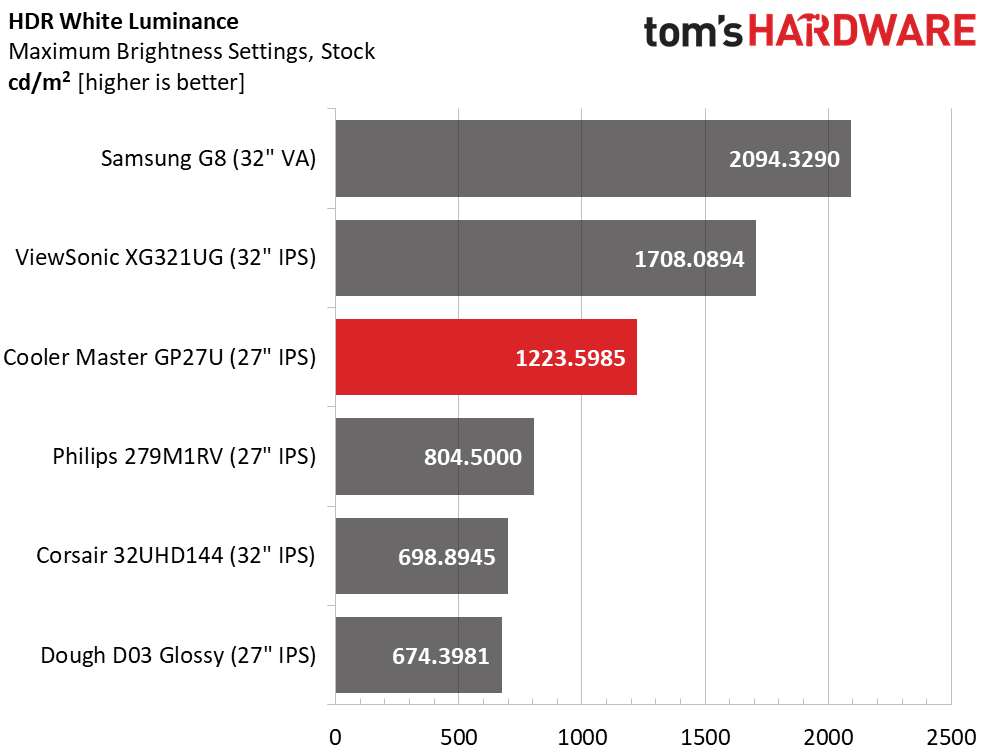
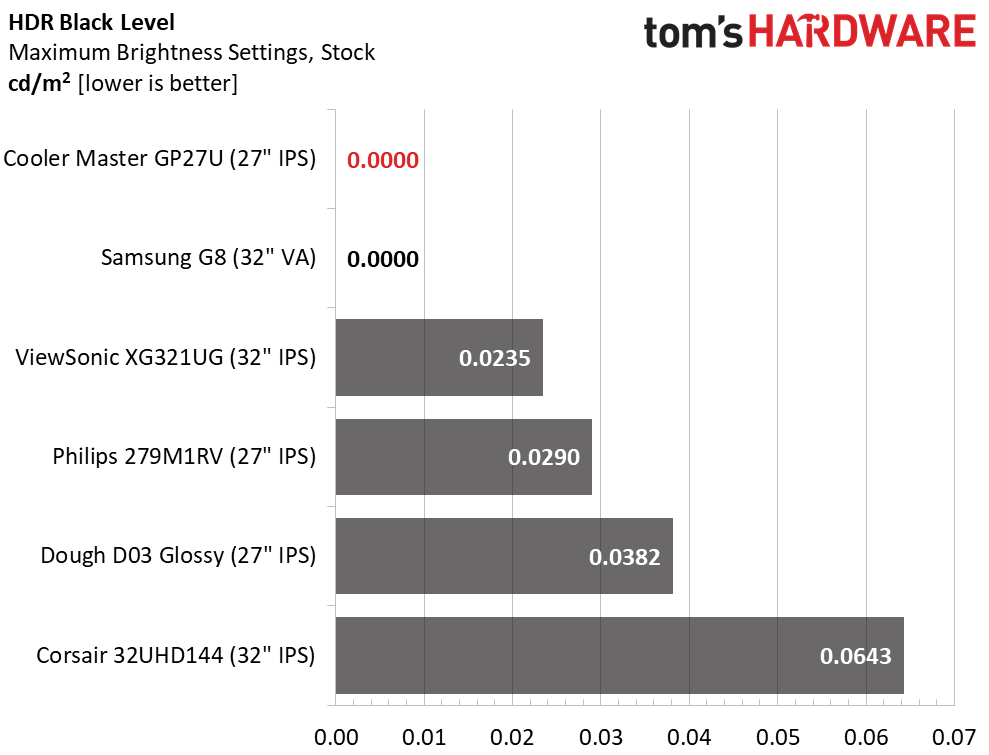
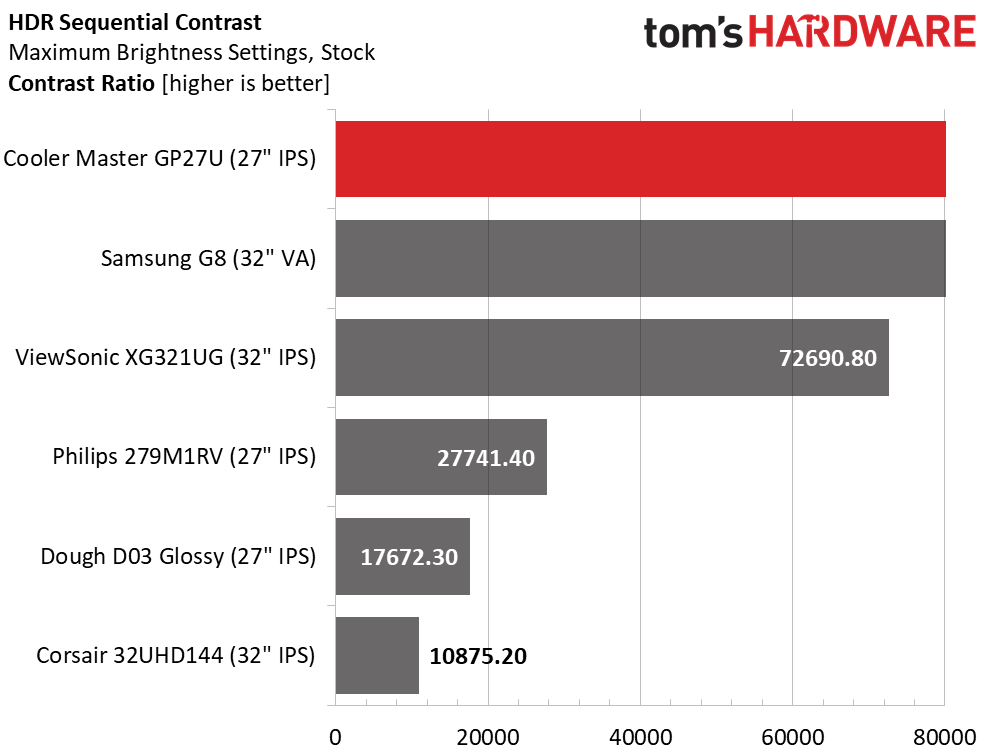
I didn’t have to measure window patterns to see over 1,200 nits. The GP27U can render a full-field white pattern at its maximum brightness. It hurt my eyes to look at it for more than a moment. This is great for HDR content because highlights really pop out. The picture is not harsh in practice. Black levels are unmeasurable because the GP27U turns off its backlight in any zone showing a zero-percent signal. That means its HDR contrast cannot be measured. It and the G8 are the only LCD panels I’ve encountered with this behavior. The ViewSonic is close behind with over 72,000:1 contrast. That the last-place screen has nearly 11,000:1 speaks volumes for this genre. You won’t find a bad HDR image in the bunch.
Grayscale, EOTF and Color
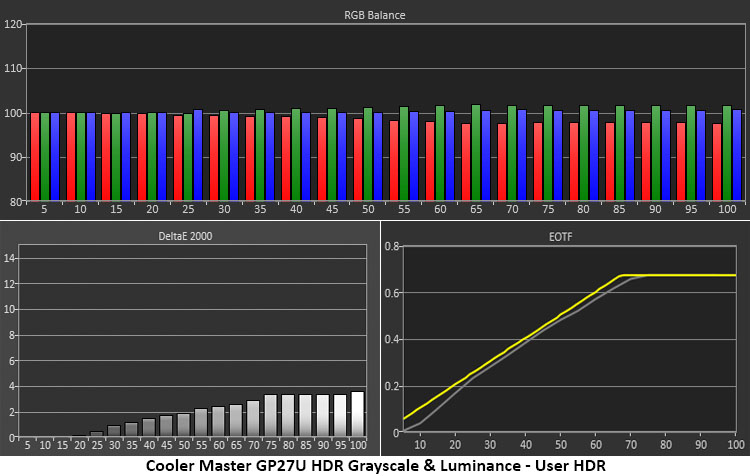
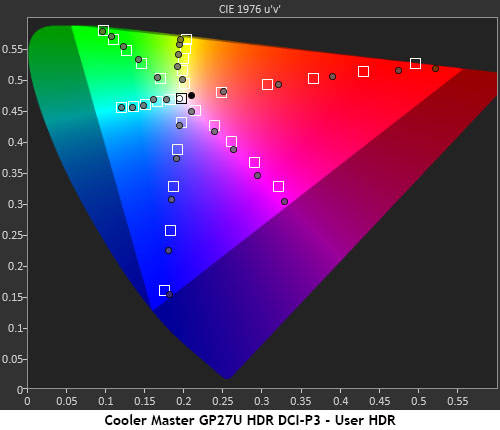
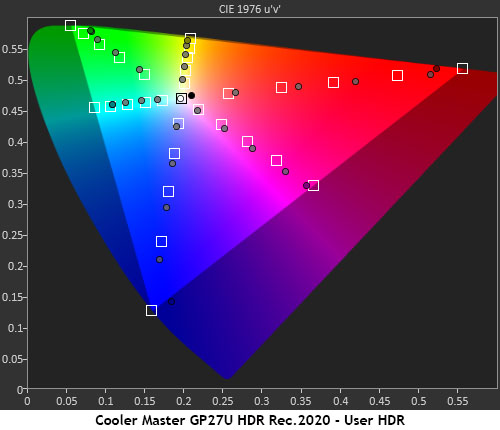
The GP27U defaults to its User HDR mode, and that is the one I recommend. Switch Local Dimming to Low for the best luminance tracking and contrast. Higher settings clip both highlight and shadow detail. The other two HDR modes also clip detail and should be avoided. Grayscale tracking is visually perfect, as is the EOTF, which transitions perfectly at 65% brightness. Color tracking is slightly over-saturated for both DCI-P3 and Rec.2020 rendered content. Hue points are all in line with their targets. The GP27U is a benchmark for HDR accuracy and performance.
MORE: Best Gaming Monitors
MORE: How We Test PC Monitors
MORE: How to Buy a PC Monitor: A 2022 Guide
Get Tom's Hardware's best news and in-depth reviews, straight to your inbox.
MORE: How to Choose the Best HDR Monitor

Christian Eberle is a Contributing Editor for Tom's Hardware US. He's a veteran reviewer of A/V equipment, specializing in monitors. Christian began his obsession with tech when he built his first PC in 1991, a 286 running DOS 3.0 at a blazing 12MHz. In 2006, he undertook training from the Imaging Science Foundation in video calibration and testing and thus started a passion for precise imaging that persists to this day. He is also a professional musician with a degree from the New England Conservatory as a classical bassoonist which he used to good effect as a performer with the West Point Army Band from 1987 to 2013. He enjoys watching movies and listening to high-end audio in his custom-built home theater and can be seen riding trails near his home on a race-ready ICE VTX recumbent trike. Christian enjoys the endless summer in Florida where he lives with his wife and Chihuahua and plays with orchestras around the state.
-
healthy Pro-teen Reply
it depends on the resolution you want, for example, the Alienware QD-OLED monitor is 175HZ and not a lot more expensive but it's 1440P instead of 4K. the tempest is the fine value at a thousand dollars.helper800 said:Not OLED and >1000 dollars, no thank you. -
helper800 Reply
You can get a 4k OLED for less than a thousand dollars...healthy Pro-teen said:it depends on the resolution you want, for example, the Alienware QD-OLED monitor is 175HZ and not a lot more expensive but it's 1440P instead of 4K. the tempest is the fine value at a thousand dollars.
Newegg has since changed the link to a different product. The Aorus FO48U monitor. -
PlaneInTheSky ReplyAlienware QD-OLED monitor is 175HZ and not a lot more expensive but it's 1440P instead of 4K
Samsung's QD-OLED (which that Alienware uses) has a lot of artefacts and color fringing issues.
Just search "color fringing qd-oled" and you'll get hundreds of people pointing out the issues with QD-OLED.
OLED has this problem in general, but it is worse on the QD-OLED from samsung.
-
helper800 Reply
When you are viewing content and playing games there are no issues. This issue with QD-OLED is also partially a windows problem because they do not support the pixel layout of the monitor. You can get a 3rd party program that fixes this issue for non-windows ui and text elements within it. You can completely fix this issue for W-OLED with ClearType.PlaneInTheSky said:Samsung's QD-OLED (which that Alienware uses) has a lot of artefacts and color fringing issues.
Just search "color fringing qd-oled" and you'll get hundreds of people pointing out the issues with QD-OLED.
OLED has this problem in general, but it is worse on the QD-OLED from samsung.
-
PlaneInTheSky ReplyWhen you are viewing content and playing games there are no issues.
In every game with text, the color fringing of QD-OLED and OLED, IS a major issue.
Monitor makers are trying to damage control this issue, but when people are paying so much money for an OLED monitor and they realize OLED tech has color fringing issues that even $100 VA or IPS panels don't have, that leaves a very sour taste in people's mouth.
The color fringing is also an issue with high contrast UI elements.
-
helper800 Reply
I am literally staring at this on my W-OLED tv 44 inches from my eyes and cannot distinguish any fringing. My brother's QD-OLED has some fringing at appropriate viewing distances but, like I said, there are 3rd party text clarity programs that can fix the issue in some circumstances.PlaneInTheSky said:In every game with text, the color fringing of QD-OLED and OLED, IS a major issue.
Monitor makers are trying to damage control this issue, but when people are paying so much money for an OLED monitor and they realize OLED tech has color fringing issues that even $100 VA or IPS panels don't have, that leaves a very sour taste in people's mouth.
The color fringing is also an issue with high contrast UI elements.
52eiLP3Zy-sView: https://www.youtube.com/watch?app=desktop&v=52eiLP3Zy-s -
Lug "The only caveat is that you must turn off Adaptive-Sync to go above 144 Hz "Reply
Not with firmware update from December 2022.. :
Changelog:
Adaptive Sync (VRR) and Local Dimming can now be enabled together.Fixed some instances where the KVM would not automatically switch to a new signal input.
More overall flexible color adjustments in all picture modes.
Enabling Adaptive Sync will no longer limit the refresh rate to 144Hz, and instead works up to 160Hz (both HDMI 2.1 and DP). -
healthy Pro-teen Reply
That AORUS FO48U could be a legit alternative, but The tempest has Brighter, better HDR, and a higher refresh rate. I'll consider it If it ever comes back into stock.helper800 said:You can get a 4k OLED for less than a thousand dollars...